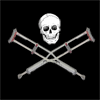Thursday, May 11, 2006
Pluto isn't a planet
For anyone who cares, this is the speech I gave today.
My very educated mother just sent us nine pizzas. How many of you learned a mnemonic like this to remember the planets? Along with most of you, I was taught about the planets early on in school. The ninth, I was taught, is Pluto. But there is a lot of information showing that Pluto is not a planet.
First of all, Pluto is by far the smallest thing we call a planet. The next smallest is Mercury, and it is twice the diameter of Pluto. In comparison Pluto’s diameter is less than a fifth of Earth’s. In fact Pluto is smaller than seven of the moons in our solar system, including ours. To drive around Pluto’s equator would be like driving from Chicago to LA and back.
Pluto’s size isn’t the only thing that makes it different than the planets. Most planets’ orbits lie on an imaginary plane that the Earth’s orbit is in, but Pluto’s orbit is seventeen degrees off of this plane. This tilt is more like some comets than like the planets. Besides the tilt, Pluto’s orbit passes over Neptune’s. No planet’s orbit carries it over another, but there are several other things, like asteroids and comets, that do.
Pluto is only part of a mini-system. Pluto is usually considered the center of this system, with moons orbiting, but that’s not exactly the case. The second largest member of this system is Charon. Charon is over half the size of Pluto, a situation that doesn’t arise in any planet’s situation. Because of this, Pluto and Charon orbit a point partway between them. Every planet directly orbits the sun. Every moon constantly faces the planet it orbits while the planet turns beneath it. Unlike any of the planets, Pluto and Charon face each other constantly.
One thing that makes a planet a planet is being almost alone in its area. Earth is alone except for the moon, and a very small number of asteroids. Pluto is not alone in its orbit. There are dozens of objects in the Kuiper Belt, which is a group of objects similar to the asteroid belt, but farther from the sun. Some of these objects are nearly the size of Pluto.
The first asteroid discovered was, naturally, the largest. It was originally dubbed a planet, but when more asteroids were discovered, all of them were grouped together. In much the same way, Pluto is probably the largest Kuiper Belt object, and was discovered first, named a planet, and should now be demoted.
Part of the reason Pluto is called a planet is that the people who found it were looking for a planet. They mistakenly thought there was a large planet further out than Neptune, and set out to find it. When they saw Pluto they thought it must be a planet. Because of the low technology of the time, it was originally thought that Pluto and Charon were one larger planet. However, when the error was discovered, Pluto remained a planet.
There are things beyond and around Pluto that test its planet hood. Quaoar is one of these things. It is rather close to the size of Pluto, and is located in a similar location, and actually follows a more planet-like orbit. Farther out there are even more things to be discovered. Sedna is a recent discovery, nearly the size of Pluto and 2003 UB313, is even bigger than Pluto. These are unlikely to gain status as planets, though.
Pluto is only a planet because those who found it were looking for a planet, and people tend to see what they want to see. Because of its unremarkable size and strange orbit, Pluto is unlike any planet, but it is the fact that it is just one of several large objects that proves it is not a planet.
and the sources, of course
http://www.gps.caltech.edu/~mbrown/sedna/#planets
http://home.case.edu/~sjr16/comets.html
http://en.wikipedia.org/wiki/Pluto
http://www.seds.org/nineplanets/nineplanets
Do you feel persuaded?
My very educated mother just sent us nine pizzas. How many of you learned a mnemonic like this to remember the planets? Along with most of you, I was taught about the planets early on in school. The ninth, I was taught, is Pluto. But there is a lot of information showing that Pluto is not a planet.
First of all, Pluto is by far the smallest thing we call a planet. The next smallest is Mercury, and it is twice the diameter of Pluto. In comparison Pluto’s diameter is less than a fifth of Earth’s. In fact Pluto is smaller than seven of the moons in our solar system, including ours. To drive around Pluto’s equator would be like driving from Chicago to LA and back.
Pluto’s size isn’t the only thing that makes it different than the planets. Most planets’ orbits lie on an imaginary plane that the Earth’s orbit is in, but Pluto’s orbit is seventeen degrees off of this plane. This tilt is more like some comets than like the planets. Besides the tilt, Pluto’s orbit passes over Neptune’s. No planet’s orbit carries it over another, but there are several other things, like asteroids and comets, that do.
Pluto is only part of a mini-system. Pluto is usually considered the center of this system, with moons orbiting, but that’s not exactly the case. The second largest member of this system is Charon. Charon is over half the size of Pluto, a situation that doesn’t arise in any planet’s situation. Because of this, Pluto and Charon orbit a point partway between them. Every planet directly orbits the sun. Every moon constantly faces the planet it orbits while the planet turns beneath it. Unlike any of the planets, Pluto and Charon face each other constantly.
One thing that makes a planet a planet is being almost alone in its area. Earth is alone except for the moon, and a very small number of asteroids. Pluto is not alone in its orbit. There are dozens of objects in the Kuiper Belt, which is a group of objects similar to the asteroid belt, but farther from the sun. Some of these objects are nearly the size of Pluto.
The first asteroid discovered was, naturally, the largest. It was originally dubbed a planet, but when more asteroids were discovered, all of them were grouped together. In much the same way, Pluto is probably the largest Kuiper Belt object, and was discovered first, named a planet, and should now be demoted.
Part of the reason Pluto is called a planet is that the people who found it were looking for a planet. They mistakenly thought there was a large planet further out than Neptune, and set out to find it. When they saw Pluto they thought it must be a planet. Because of the low technology of the time, it was originally thought that Pluto and Charon were one larger planet. However, when the error was discovered, Pluto remained a planet.
There are things beyond and around Pluto that test its planet hood. Quaoar is one of these things. It is rather close to the size of Pluto, and is located in a similar location, and actually follows a more planet-like orbit. Farther out there are even more things to be discovered. Sedna is a recent discovery, nearly the size of Pluto and 2003 UB313, is even bigger than Pluto. These are unlikely to gain status as planets, though.
Pluto is only a planet because those who found it were looking for a planet, and people tend to see what they want to see. Because of its unremarkable size and strange orbit, Pluto is unlike any planet, but it is the fact that it is just one of several large objects that proves it is not a planet.
and the sources, of course
http://www.gps.caltech.edu/~mbrown/sedna/#planets
http://home.case.edu/~sjr16/comets.html
http://en.wikipedia.org/wiki/Pluto
http://www.seds.org/nineplanets/nineplanets
Do you feel persuaded?
Comments:
<< Home
everything makes sense, yes, and it is persuasive, but i guess i'll always think of Pluto as a planet :-). Now to study for Spanish...
~horsey
Post a Comment
~horsey
<< Home


